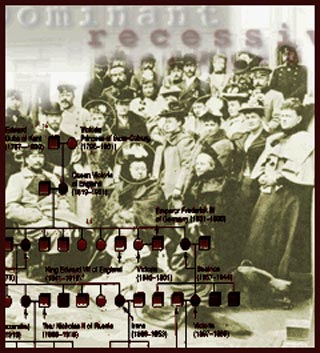Concept 13 Mendelian laws apply to human beings.

Although Mendel's laws were first tested in pea plants and fruit flies, evidence quickly mounted that they applied to all living things. Just as mutations had provided keys to understanding fruit fly genetics, pedigrees of families affected by diseases provided many of the first examples of Mendelian inheritance in humans.
Recessive inheritance was first described for the disorders alkaptonuria (1902) and albinism (1903). Among the first dominant disorders discovered were brachydactyly (short fingers, 1905), congenital cataracts (1906), and Huntington's chorea (1913). Duchenne muscular dystrophy (1913), red-green color blindness (1914), and hemophilia (1916) were the first sex-linked disorders. The simple concept of eye color inheritance — brown is dominant, blue is recessive — was published in 1907; however, scientists now believe that several genes are involved.
 Children resemble their parents.
Children resemble their parents. Genes come in pairs.
Genes come in pairs. Genes don't blend.
Genes don't blend. Some genes are dominant.
Some genes are dominant. Genetic inheritance follows rules.
Genetic inheritance follows rules. Genes are real things.
Genes are real things. All cells arise from pre-existing cells.
All cells arise from pre-existing cells. Sex cells have one set of chromosomes; body cells have two.
Sex cells have one set of chromosomes; body cells have two. Specialized chromosomes determine sex.
Specialized chromosomes determine sex. Chromosomes carry genes.
Chromosomes carry genes. Genes get shuffled when chromosomes exchange pieces.
Genes get shuffled when chromosomes exchange pieces. Evolution begins with the inheritance of gene variations.
Evolution begins with the inheritance of gene variations. Mendelian laws apply to human beings.
Mendelian laws apply to human beings. Mendelian genetics cannot fully explain human health and behavior.
Mendelian genetics cannot fully explain human health and behavior.